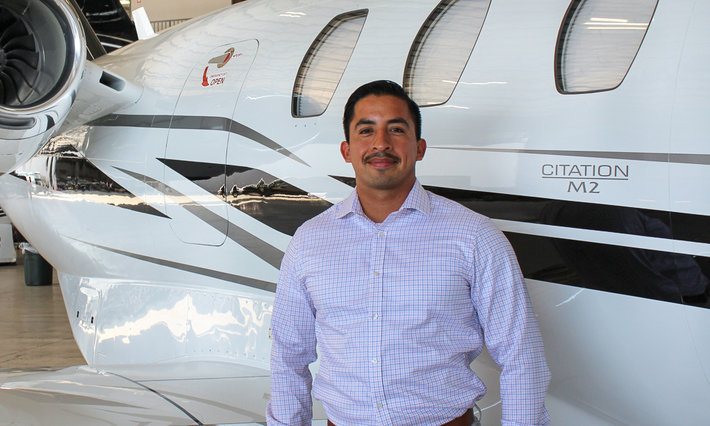In our current series, Business Airport International speaks with some of the recipients of NBAA’s 40 Under 40 awards for 2018. This week, Danny Perez, first officer at Latitude 33 Aviation, discusses the intimacy of business aviation, the looming pilot shortage crisis and the challenges life as a pilot entail.
What was your first job in the business aviation industry?
My first job in business aviation is my current job, with Latitude 33 Aviation as a Cessna Citation CJ3 first officer.
How is your career progressing?
Since starting at Latitude 33, a year and a half ago, I have gained over 1,000 hours of jet flying experience. Additionally, I have been type rated as an SIC in an Embraer Phenom 300. Earlier this year, I applied for and won a scholarship through the Southern California Aviation Association (SCAA) for a PIC type rating in the CJ3. Most recently, I have been granted the opportunity to fly a much larger aircraft within Latitude 33 Aviation and accepted a position to be trained in the Challenger 605.
Why do you enjoy working in the business aviation industry?
I have always enjoyed the intimacy of business aviation. There is a close relationship with your colleagues and employer. Everyone knows each other on a first name basis and you feel part of a team. I also enjoy the customer service aspect of the industry. On each flight, I help personalize and enhance the clients’ experience. This allows me to connect and build relationships with regular clients, and of course, the owners.
I also enjoy the adventure that comes with the job. As a pilot, I have the luxury of seeing some of the most unique, sometimes exotic, airports and destinations. Often, we have time to explore these destinations.
What is one of your fondest memories from your business aviation career so far?
There are so many adventures to choose from but, as cheesy as it sounds, one of the most memorable or at least most rewarding experiences this job has brought me is the opportunity to fly with my best friend, Ricky Rivero. Coincidentally enough, our first trip together was around my birthday this past April, so it was a pleasant surprise. Ricky and I grew up on the same street together since elementary school, and he was the one who first introduced me to aviation. Twenty-some years later, we finally have the opportunity to work and fly together as captain and first officer thanks to Latitude 33 Aviation.
What is one of your most challenging times in this industry?
The most challenging aspect of this career is the time spent away from friends and family. I am thankful for their patience, support, and understanding of the obstacles that this career brings. Because of the schedule of being a pilot, I often miss birthdays, weddings and holidays. Luckily my past military experience has inadvertently trained me for this lifestyle.
What is your favourite aircraft to fly?
As of now, the Phenom 300 is my favorite aircraft to fly. From a pilot’s standpoint, it surpasses all the other aircraft in its class with comfort and amenities. It has all the bells and whistles you could want in a light jet.
What do you believe makes a great FBO/business aviation facility?
A great FBO makes the crew and passengers feel welcome. As obvious as that sounds, this is often forgotten. The passengers should be greeted with authentic smiles and the ‘greeting of the day’ as their bags are unloaded or loaded for them. The amenities and comfort of the facility is usually a big factor for some operators, but personally an excellent FBO should emphasize the overall customer service experience.
Based on my personal experiences, ACI Jet in San Luis Obispo, California, has repeatedly exceeded this simple expectation. I have visited ACI as both a client in a small piston aircraft and as a professional pilot in a multimillion-dollar jet. The ACI Jet team treated me like a VIP each time. I was greeted with authentic smiles and was catered to with no attitude.
All of the employees I have encountered during each of my visits appeared genuinely happy to be there and always spoke highly of their employer. The actual facility itself is comfortable and equipped with a crew lounge and cozy lobby, which offers ice cream, coffee, and hot cocoa.
What do you believe are the key challenges that need to be addressed? What are the key challenges and opportunities in your region?
The biggest challenge that the entirety of aviation is facing is a massive pilot shortage, even more so in business aviation. Aside from the higher minimum requirements in order to obtain an ATP license, one of the biggest obstacles is the lack of knowledge that the general public has about becoming a professional pilot.
In the past five years, airlines have made moves to bring more exposure to the pilot shortage. Many regional airlines have now begun recruiting pilots, something never seen before in the aviation history. Pilots who are lifelong instructors, crop dusters, and banner towers are now able to make the jump to jet aircraft. Similarly, I believe that business aviation needs to create a defined approach to educate others on how to become a professional pilot.
What paved the way for me to become a professional pilot was the chance I was given to use my military benefits to fund my flight training. Coast Flight Training, my former flight school in San Diego, is one of few FAA Part 141 schools in Southern California that enable students to earn their Associates degree while obtaining the required flight training on the path to becoming a commercial pilot. Veterans of the armed forces are able to use the G.I. Bill to fund most of the cost. Southern California, particularly San Diego, is host to many Navy and Marine Corps service members. These members would make great pilots if given the exposure and information about starting a career in aviation.





